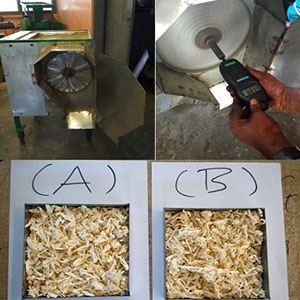Effect of variable chipping clearance and operational speed on the cassava chip geometry

Published: 28 June 2022
Abstract Views: 566
PDF: 334
HTML: 112
HTML: 112
Publisher's note
All claims expressed in this article are solely those of the authors and do not necessarily represent those of their affiliated organizations, or those of the publisher, the editors and the reviewers. Any product that may be evaluated in this article or claim that may be made by its manufacturer is not guaranteed or endorsed by the publisher.
All claims expressed in this article are solely those of the authors and do not necessarily represent those of their affiliated organizations, or those of the publisher, the editors and the reviewers. Any product that may be evaluated in this article or claim that may be made by its manufacturer is not guaranteed or endorsed by the publisher.
Similar Articles
- Giuseppe Rossi, Leonardo Conti, Lorenzo Fiorineschi , Massimiliano Marvasi, Massimo Monti, Federico Rotini, Marco Togni, Matteo Barbari, A new eco-friendly packaging material made of straw and bioplastic , Journal of Agricultural Engineering: Vol. 51 No. 4 (2020)
- Abderrahman Sghaier, Hanen Dhaou, Lassaad Jarray , Zouhair Abaab, Ahmed Sekrafi, Mohamed Ouessar , Assessment of drought stress in arid olive groves using HidroMORE model , Journal of Agricultural Engineering: Vol. 53 No. 1 (2022)
- Valentina Giovenzana, Roberto Beghi, Riccardo Guidetti, Massimiliano Luison, Tiziana Nardi, Evaluation of energy savings in white winemaking: impact of temperature management combined with specific yeasts choice on required heat dissipation during industrial-scale fermentation , Journal of Agricultural Engineering: Vol. 54 No. 3 (2023)
- Emanuele Cerruto, Claudia Aglieco, Sabina Failla, Giuseppe Manetto, Parameters influencing deposit estimation when using water sensitive papers , Journal of Agricultural Engineering: Vol. 44 No. 2 (2013)
- Irene Diti, Daniele Torreggiani, Patrizia Tassinari, Rural landscape and cultural routes: a multicriteria spatial classification method tested on an Italian case study , Journal of Agricultural Engineering: Vol. 46 No. 1 (2015)
- Ali Saeed, Alessandro Comegna, Giovanna Dragonetti, Nicola Lamaddalena, Angelo Sommella, Antonio Coppola, Soil electrical conductivity estimated by time domain reflectometry and electromagnetic induction sensors: Accounting for the different sensor observation volumes , Journal of Agricultural Engineering: Vol. 48 No. 4 (2017)
- Marco Bovo, Alberto Barbaresi, Daniele Torreggiani, Patrizia Tassinari, Report on earthquake-induced failures of rural buildings aimed at future preservation strategies , Journal of Agricultural Engineering: Vol. 50 No. 2 (2019)
- Andrea Casson, Valentina Giovenzana, Alessio Tugnolo, Alessia Pampuri, Ilaria Fiorindo, Roberto Beghi, Riccardo Guidetti, Assessment of an expanded-polypropylene isothermal box to improve logistic sustainability of catering services , Journal of Agricultural Engineering: Vol. 52 No. 2 (2021)
- Fan Cui, Guoqi Dong, Baiping Chen, Penglin Yong, Suping Peng, Application of ground penetrating radar technology in moisture content detection of stored grain , Journal of Agricultural Engineering: Vol. 54 No. 1 (2023)
- Hemanthakumar R. Kappali, Sadyojatha K.M., Prashanthi S.K., Parametric evaluation of segmentation techniques for paddy diseases analysis , Journal of Agricultural Engineering: Vol. 54 No. 4 (2023)
<< < 30 31 32 33 34 35 36 > >>
You may also start an advanced similarity search for this article.

 https://doi.org/10.4081/jae.2022.1303
https://doi.org/10.4081/jae.2022.1303







